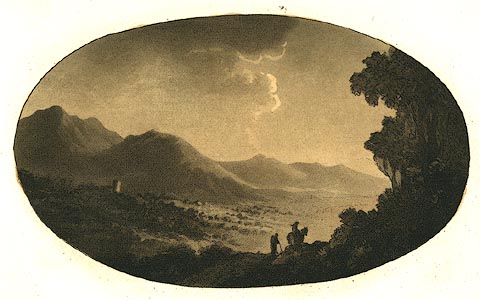

Dove Cottage : 2008.107.424
image:-
© see bottom of page

click to enlarge
Included in vol.2 opposite p.41 in Observations, Relative Chiefly to Picturesque Beauty, made in the year 1772.
The list of plates in the preface of the book has:-
'XVI. AN illustration of that beautiful species of landscape, produced by an extensive vale. Gradation is among the first principles of picturesque beauty. A graduating light, a graduating shade, or a graduating distance, are all beautiful. When the vale therefore does not exceed such a proportion, as is adapted to the eye, it is pleasing to see it fading away gradually, from the foreground, into the obscurity of distance. It presents indeed only one uniform idea; which, tho often grand, is not generally so pleasing, as the variety, and intricacy of a country broken into parts, and yet harmoniously combined. Page 41.'
'... As we rode nearer the northern limit of this chain, Skiddaw, which is by much the highest mountain, appeared in perspective, the least. Behind these mountains arise, in order, Mosedale-fell - Carric - and Caudbeck - the tops of which we sometimes saw, from the higher grounds, peering, in their blue attire, over the concave parts of the browner mountains, which stood nearer the eye.
'Between us, and this circular chain, which occupied the whole horizon on the left, was spread a very extensive vale; stretching from side to side hardly less the seven or eight miles; and in length winding out of sight. It affords little beauty, except what arises from the gradations of distance: but it suggests an idea of greatness; which space, and grand boundaries, however unadorned, will always suggest.
'This idea hath sometimes misled the tasteless improver of little scenes. He has heard, the space gives beauty; but not knowing how to accommodate the rule to circumstances, he often shews all that is to be seen; when, in fact, he should have hid half of it, as a deformity. Mere space gives the idea of grandeur, rather than of beauty. Such an idea the ocean presents. Grandeur therefore is not attained by attempting it; while beauty is often lost. ...'
 Vale, A
Vale, A